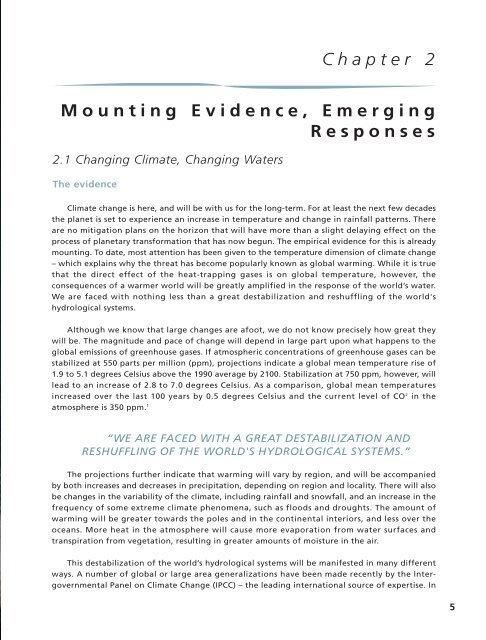Adaptation of water resources management to climate change
Adaptation of water resources management to climate change
Adaptation of water resources management to climate change
You also want an ePaper? Increase the reach of your titles
YUMPU automatically turns print PDFs into web optimized ePapers that Google loves.
Chapter 2Mounting Evidence, EmergingResponses2.1 Changing Climate, Changing WatersThe evidenceClimate <strong>change</strong> is here, and will be with us for the long-term. For at least the next few decadesthe planet is set <strong>to</strong> experience an increase in temperature and <strong>change</strong> in rainfall patterns. Thereare no mitigation plans on the horizon that will have more than a slight delaying effect on theprocess <strong>of</strong> planetary transformation that has now begun. The empirical evidence for this is alreadymounting. To date, most attention has been given <strong>to</strong> the temperature dimension <strong>of</strong> <strong>climate</strong> <strong>change</strong>– which explains why the threat has become popularly known as global warming. While it is truethat the direct effect <strong>of</strong> the heat-trapping gases is on global temperature, however, theconsequences <strong>of</strong> a warmer world will be greatly amplified in the response <strong>of</strong> the world’s <strong>water</strong>.We are faced with nothing less than a great destabilization and reshuffling <strong>of</strong> the world'shydrological systems.Although we know that large <strong>change</strong>s are afoot, we do not know precisely how great theywill be. The magnitude and pace <strong>of</strong> <strong>change</strong> will depend in large part upon what happens <strong>to</strong> theglobal emissions <strong>of</strong> greenhouse gases. If atmospheric concentrations <strong>of</strong> greenhouse gases can bestabilized at 550 parts per million (ppm), projections indicate a global mean temperature rise <strong>of</strong>1.9 <strong>to</strong> 5.1 degrees Celsius above the 1990 average by 2100. Stabilization at 750 ppm, however, willlead <strong>to</strong> an increase <strong>of</strong> 2.8 <strong>to</strong> 7.0 degrees Celsius. As a comparison, global mean temperaturesincreased over the last 100 years by 0.5 degrees Celsius and the current level <strong>of</strong> CO 2 in theatmosphere is 350 ppm. 1“WE ARE FACED WITH A GREAT DESTABILIZATION ANDRESHUFFLING OF THE WORLD'S HYDROLOGICAL SYSTEMS.”The projections further indicate that warming will vary by region, and will be accompaniedby both increases and decreases in precipitation, depending on region and locality. There will alsobe <strong>change</strong>s in the variability <strong>of</strong> the <strong>climate</strong>, including rainfall and snowfall, and an increase in thefrequency <strong>of</strong> some extreme <strong>climate</strong> phenomena, such as floods and droughts. The amount <strong>of</strong>warming will be greater <strong>to</strong>wards the poles and in the continental interiors, and less over theoceans. More heat in the atmosphere will cause more evaporation from <strong>water</strong> surfaces andtranspiration from vegetation, resulting in greater amounts <strong>of</strong> moisture in the air.This destabilization <strong>of</strong> the world’s hydrological systems will be manifested in many differentways. A number <strong>of</strong> global or large area generalizations have been made recently by the IntergovernmentalPanel on Climate Change (IPCC) – the leading international source <strong>of</strong> expertise. In5











![View full document [PDF 988.55 KB] - PreventionWeb](https://img.yumpu.com/47733942/1/184x260/view-full-document-pdf-98855-kb-preventionweb.jpg?quality=85)
![View full document (in French) [PDF 4.96 MB] - PreventionWeb](https://img.yumpu.com/47223870/1/184x260/view-full-document-in-french-pdf-496-mb-preventionweb.jpg?quality=85)


![View full document [PDF 25.02 MB] - PreventionWeb](https://img.yumpu.com/44204570/1/190x234/view-full-document-pdf-2502-mb-preventionweb.jpg?quality=85)
